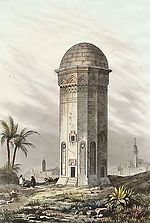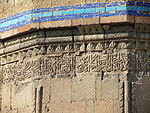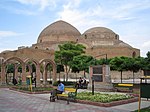Kara Koyunlu
Jump to navigationJump to search
|
Kara Koyunlular
Black Sheep Turkomans
قره قویونلو |
|||||||||||
|---|---|---|---|---|---|---|---|---|---|---|---|
| 1374–1468 | |||||||||||
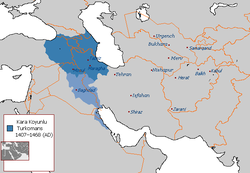
Kara Koyunlu of the Turkomans, lighter blue shows their greatest extent in Iraq and Arabian East Coast for a small period of time
|
|||||||||||
| Status | Confederation | ||||||||||
| Capital | Tabriz | ||||||||||
| Common languages |
|
||||||||||
| Religion | Shia Islam | ||||||||||
| Government | Monarchy | ||||||||||
| Ruler | |||||||||||
|
• 1375–1378
|
Bayram Khwaja | ||||||||||
|
• 1467–1468
|
Hasan ‘Ali | ||||||||||
| Historical era | Middle Ages | ||||||||||
|
• Established
|
1374 | ||||||||||
|
• Disestablished
|
1468 | ||||||||||
|
|||||||||||
|
Part of a series on the
|
|---|
| History of Azerbaijan |
 |
|
Part of a series on the
|
|---|
| History of Turkey |
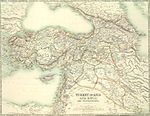 |
|
Part of a series on the
|
|---|
| History of Iran |
 |
| Timeline |
The Kara Koyunlu or Qara Qoyunlu, also called the Black Sheep Turkomans (Persian: قره قویونلو), were a Muslim Turkoman[2][3][4] monarchy that ruled over the territory comprising present-day Azerbaijan, Georgia, Armenia, northwestern Iran, eastern Turkey, and northeastern Iraq from about 1374 to 1468.[5][6]
History[edit]
Origins[edit]
The ruling family descended from the Yıva tribe of the Oghuz Turks, specifically the Baharlu tribe,[7] who by the 14th century possessed territories north of the Van Lake and Mosul, in Northern Iraq.[8] The tribes that comprised the Kara Koyunlu besides Baharlu were Saadlu, Karamanlu, Alpaut, Dukharlu, Jagirlu, Hajilu, Agacheri.[9]
Rise[edit]
The Kara Koyunlu Turkomans at one point established their capital in Herat in modern-day Afghanistan.[10] They were vassals of the Jalairid Sultanate in Baghdad and Tabriz from about 1375, when the leader of their leading tribe ruled over Mosul. However, they rebelled against the Jalairids, and secured their independence from the dynasty with the conquest of Tabriz by Qara Yusuf. In 1400, Timur defeated the Kara Koyunlu, and Qara Yusuf fled to Egypt, seeking refuge with the Mamluk Sultanate. He gathered an army and by 1406 had taken back Tabriz.
In 1410, the Kara Koyunlu captured Baghdad. The installation of a subsidiary Kara Koyunlu line there hastened the downfall of the Jalairids they had once served. Despite internal fighting among Qara Yusuf’s descendants after his death in 1420, The Garagoyunlu state collapsed after Gara Yusif. Gara Iskander, whose son Gara Iskander’s wrong actions and bowing to the Timurid state brought the state to collapse, died. He was replaced by Emperor Haqiqi. Due to the mistakes of his predecessor, Shahrukh Shah, the king of the Timurid state, was the first to convene a party in the palace. They brought the Timurids to the capital. But he went to war with his enemies, the Aghkoyunlular. Jahanshah Haqiqi died in the battle of Mus. Garagoyunlu was almost destroyed. This time Hasanali Mirza came to power, but was killed by Uzun Hasan and the Garagoyunlu state collapsed.[11]
Decline[edit]
In 1410 Armenia fell under the control of the Kara Koyunlu. The principal Armenian sources available in this period come from the historian Tovma Metsopetsi and several colophons to contemporary manuscripts.[12] According to Tovma, although the Kara Koyunlu levied heavy taxes against the Armenians, the early years of their rule were relatively peaceful and some reconstruction of towns took place. This peaceful period was, however, shattered with the rise of Qara Iskander, who reportedly made Armenia a “desert” and subjected it to “devastation and plunder, to slaughter, and captivity”.[13] Iskander’s wars with and eventual defeat by the Timurids invited further destruction in Armenia, as many Armenians were taken captive and sold into slavery and the land was subjected to outright pillaging, forcing many of them to leave the region.[14] Iskander did attempt to reconcile with the Armenians by appointing an Armenian from a noble family, Rustum, as one of his advisers.
When the Timurids launched their final incursion into the region, they convinced Jihanshah, Iskander’s brother, to turn on his brother. Jihanshah pursued a policy of persecution against the Armenians in Syunik and colophons to Armenian manuscripts record the sacking of the Tatev monastery by his forces.[14] But he, too, sought a rapprochement with the Armenians, allotting land to feudal lords, rebuilding churches, and approving the relocation of the seat of the Armenian Apostolic Church‘s Catholicos to Etchmiadzin Cathedral in 1441. For all this, Jihanshah continued to attack Armenian towns and take Armenian captives as the country saw further devastation in the final years of Jihanshah’s failed struggles with the Aq Qoyunlu.[15]
Jahan Shah made peace with the Timurid Shahrukh Mirza; however, this soon fell apart. When Shahrukh Mirza died in 1447, the Kara Koyunlu Turkomans annexed portions of Iraq and the eastern coast of the Arabian Peninsula as well as Timurid-controlled western Iran. Though much territory was gained during his rule, Jahān Shāh’s reign was troubled by his rebellious sons and the almost autonomous rulers of Baghdad, whom he expelled in 1464. In 1466, Jahan Shah attempted to take Diyarbakır from the Aq Qoyunlu (“White Sheep Turkomans”), however, this was a catastrophic failure resulting in Jahān Shāh’s death and the collapse of the Kara Koyunlu Turkomans’ control in the Middle East. By 1468, at their height under Uzun Hasan (1452–1478), Aq Qoyunlu defeated the Qara Qoyunlu and conquered Iraq, Azerbaijan, and western Iran.[16]
Religion[edit]
According to R. Quiring-Zoche in the Encyclopædia Iranica:
The argument that there was a clear-cut contrast between the Sunnism of the Āq Qoyunlū and the Shiʿism of the Qara Qoyunlū and the Ṣafawīya rests mainly on later Safavid sources and must be considered doubtful.[17]
C. E. Bosworth in The New Islamic Dynasties states:
As to the religious affiliations of the Qara Qoyunlu, although some of the later member of the family had Shi’i-type names and there were occasional Shi’i coin legends, there seems no strong evidence for definite Shi’i sympathies among many Turkmen elements of the time.[18]
Mausoleum of Turkmen emirs[edit]
One of the most prominent monuments built by the Kara Koyunlu dynasty remains today in the vicinity of the Armenian capital, the Mausoleum of Kara Koyunlu emirs. Turkmenistan and Armenia both contribute to the restoration and preservation of this medieval piece of architecture.
Architecture[edit]
-
Erivan tower, 1838
